The Election of the President Throughout U.S. History
Part 8: 1984 to 2016 The Election of 1984 One of Mondale's main issues was a campaign to reduce the federal budget deficit. He also voiced support for the Equal Rights Amendment.
But the election was very much a question of voters believed Reagan's claim that it was "morning in America again." Reagan's popularity, his tough stance against the spread of Communism, and the country's rising prosperity propelled the President to a massive win. Mondale won only one state, Minnesota, and that by fewer than 4,000 votes. Reagan won the District of Columbia and the other 49 states. His electoral vote total of 525 remains the highest ever. Mondale won just 13 electoral votes. The Election of 1988 Bush's main challenger for the nomination was Kansas Sen. Robert Dole, who had been Ford's running mate in 1976. Bush won the nomination but didn't choose Dole as his running mate, instead opting for Indiana Sen. Dan Quayle. The Democratic nominee was Massachusetts Gov. Michael Dukakis, who had turned back a few serious challenges during the primary sesaon but had prevailed and secured the nomination. The economy was generally strong at the time, and Bush vowed to carry on Reagan's legacy. The Bush campaign also successfully raised questions about Dukakis' experience and capabilities as a commander-in-chief. The result was a sizable Republican victory, 426-111. (One elector from West Virginia cast a vote for another candidate entirely.) The Election of 1992
This campaign was notable for the campaign of billionaire H. Ross Perot, who ran as an Independent. Perot proved a very popular candidate, winning nearly 20 million votes, despite having dropped out of the race and then re-entered it several weeks later. Perot's popularity coincided with a general dissatisfaction with the latter part of Bush's term, including his reneging on a promise not to raise income taxes. The result was an electoral victory for Clinton, 370-168. (Perot won no states.) Clinton won just 43 percent of the popular vote but won 32 states and D.C., to Bush's 18 states. The Election of 1996 Senate Majority Leader Robert Dole, a longtime leading national figure and Vice-presidential candidate in 1976, finally secured the Republican nomination for President. Dole campaigned on a large across-the-board tax cut. Clinton campaigned on his record of prosperity and bipartisanship. Billionaire H. Ross Perot ran again as an Independent and won more than eight million votes. Clinton won reelection handily, 379-159. The popular vote difference between Clinton and Dole was just more than eight million. The Election of 2000 Most polls throughout the campaign projected a victory for Gore. But Clinton's impeachment proved a distraction for many voters. Bush campaigned on, among other things, the need for co-operation in Washington. The election campaign came down to a handful of states. Vote counting went deep into the night; by the next day, every state but Florida had a declared winner. At that time, Gore had won 20 states and D.C., giving him 266 electoral votes, and Bush had won 30 states, giving him 246 electoral votes. Florida's votes were yet to be finally counted, and the 25 electoral votes for that state would determine the winner. Gore had won the overall popular vote, with just fewer than three million votes going to Green Party candidate Ralph Nader. (Significantly, Nader got 97,000 votes in Florida.) When the final tally was initially announced, Bush was ahead by about 2,000 votes. Florida state law required that a difference that small be followed up with a recount, by machine. Gore requested a recount by hand in four counties. The process became a series of legal motions, and the result was a series of legal decisions that culminated in a Supreme Court decision that halted all vote-counting, with the result that Bush won Florida, and the election. The Election of 2004 Campaign issues included national security, the economy, and America's role in the world. Kerry benefited from the continued absence of any evidence of "weapons of mass destruction" in Iraq and many people's weariness of fighting wars overseas. Bush benefited from continued confidence in the American military operations in Afghanistan, with Osama bin Laden, the mastermind of the 9/11 attacks, still at large. The election was quite close, with Bush winning 286-251. (One elector from Minnesota voted for another candidate entirely.) No Supreme Court decision was needed to decide the victor this time around. The Election of 2008 
The Republican nominee was Arizona Sen. John McCain, who had also run in 2000. McCain had emerged from a crowded field of candidates attempting to succeed Bush. The struggle for the Democratic Party nomination was a protracted battle between former First Lady Hillary Clinton and Illinois Sen. Barack Obama, with the latter finally prevailing, becoming the first African-American head of a major party presidential ticket. McCain, a war veteran, emphasized his considerable legislative experience and knowledge of world politics. Obama emphasized a need for "hope and change." One well-known feature of the election campaign was McCain's selection of former Arizona Gov. Sarah Palin as his running mate. Palin proved to be a polarizing figure. Obama benefited from being able to blame the Republican Party for an economy that was heading into recession. Obama's message proved popular across the country, and he became the first African-American President with a clear victory, winning the popular vote by 10 million votes and the electoral vote 365-173. The Election of 2012
The Republican Party took a long time to sort out a nominee. The eventual winner was former Massachusetts Gov. Mitt Romney, who had been a prime challenger to John McCain four years earlier. Romney had a history in business and innovation. He had been in charge of the Salt Lake City Winter Olympics in 2002. Romney chose as his running mate Sen. Paul Ryan of Wisconsin. The two campaigned on a message of change. Obama and Vice President Joe Biden, meanwhile, emphasized their record and their promise of better times to come.In the end, it was a clear Obama victory. The electoral tally was 332–206. Obama won all but two of the states he had won in 2008. The Election of 2016 The race featured a stark choice between the Democratic nominee, former Secretary of State and New York Senator Hillary Clinton (who was also First Lady to President Bill Clinton), and the Republican nominee, businessman and television celebrity Donald Trump. Trump made quite a name for himself by defeating other seasoned campaigners and was quite an unconventional candidate, having never held elective office and conducting his campaign in many ways not seen before. His campaign won the support of many who felt disenfranchised by the system. Clinton herself had to fend off a furious primary challenge by Vermont’s Bernie Sanders. As in 2008, Clinton was the front-runner for the Democratic Party nomination but found herself having to campaign long and hard just to win the nomination. The two nominees clashed in three well publicized television debates and traded charges throughout the campaign. Both nominees endured their share of controversies and scandals, but both nominees endured until the end, when the votes were counted and a winner was declared. Trump had cast himself as an agent of change. He campaigned on the theme, and he cast his general election opponent, Clinton, as a symbol of the kind of Washington “Old Guard” that he was determined to avoid emulating. In the end, Clinton received more popular votes than Trump did. But where the American presidential election is won, in the Electoral College, Trump got more votes than Clinton in enough states to get to the necessary number of 270 (out of 538) and won the election. |
|
Social Studies for Kids
copyright 2002–2025
David White

 Reagan, enjoying a resurgent economy, ran for re-election in 1984. His Democratic challenger was Minnesota Gov. Walter Mondale.
Reagan, enjoying a resurgent economy, ran for re-election in 1984. His Democratic challenger was Minnesota Gov. Walter Mondale. 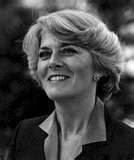
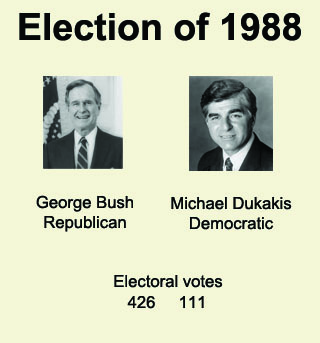 Reagan's Vice-president,
Reagan's Vice-president,  Bush ran for re-election in 1992, having secured a popularity level of 89 percent in the wake of victory in the Persian Gulf War and the end of the Cold War. But a recession was brewing, and times got tougher as the election campaign progressed.
Bush ran for re-election in 1992, having secured a popularity level of 89 percent in the wake of victory in the Persian Gulf War and the end of the Cold War. But a recession was brewing, and times got tougher as the election campaign progressed. 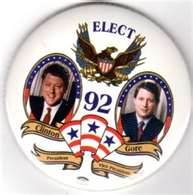 Bush's Democratic opponent was Arkansas Gov.
Bush's Democratic opponent was Arkansas Gov. 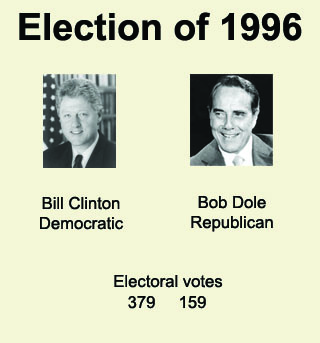 Clinton proved a popular president to some and a polarizing figure to others. His First Lady, Hillary Clinton, led a high-profile push for a national health care system, which was ultimately defeated. In the latter part of his term, he engaged in high-profile battles with the GOP-controlled Congress but also made significant deals with Republicans.
Clinton proved a popular president to some and a polarizing figure to others. His First Lady, Hillary Clinton, led a high-profile push for a national health care system, which was ultimately defeated. In the latter part of his term, he engaged in high-profile battles with the GOP-controlled Congress but also made significant deals with Republicans. 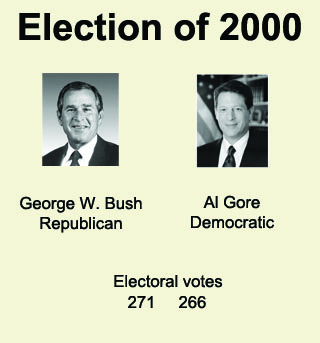 Clinton's Vice-president, Al Gore, ran for President in 2000. One of his main claims was his and Clinton's creating a large budget surplus at the end of Clinton's second term. His opponent was Texas Gov.
Clinton's Vice-president, Al Gore, ran for President in 2000. One of his main claims was his and Clinton's creating a large budget surplus at the end of Clinton's second term. His opponent was Texas Gov. 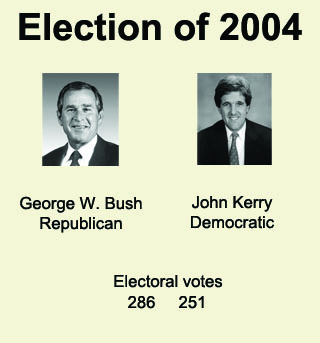 The events of September 11 and the resulting "War on Terror," coupled with the wars in Iraq and Afghanistan, were very much the dominant themes of the 2004 re-election campaign of President Bush. His Democratic opponent was Sen. John Kerry of Massachusetts.
The events of September 11 and the resulting "War on Terror," coupled with the wars in Iraq and Afghanistan, were very much the dominant themes of the 2004 re-election campaign of President Bush. His Democratic opponent was Sen. John Kerry of Massachusetts. 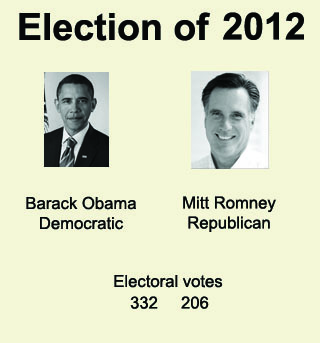 The country was starting to come out of the recession, but progress had been slow and the rest of the world was still in the economic doldrums as well. A “perfect storm” of failures in banking and stock markets, coupled with prolonged unemployment, had created worldwide economic distress, referred to by many as the Global Financial Crisis. Four years later, the U.S. economy was finally showing small signs of recovery. As well, political unrest was quite common around the world, most notably in the Middle East, in Asia, and in Afghanistan.
The country was starting to come out of the recession, but progress had been slow and the rest of the world was still in the economic doldrums as well. A “perfect storm” of failures in banking and stock markets, coupled with prolonged unemployment, had created worldwide economic distress, referred to by many as the Global Financial Crisis. Four years later, the U.S. economy was finally showing small signs of recovery. As well, political unrest was quite common around the world, most notably in the Middle East, in Asia, and in Afghanistan.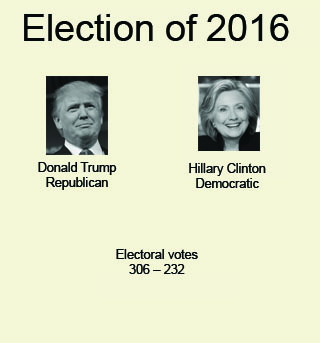 Trump had run for President a few times before but had bowed out of the race before the thick of the primary campaign. Clinton had run for President in 2008, losing narrowly to the eventual winner, Barack Obama.
Trump had run for President a few times before but had bowed out of the race before the thick of the primary campaign. Clinton had run for President in 2008, losing narrowly to the eventual winner, Barack Obama.
